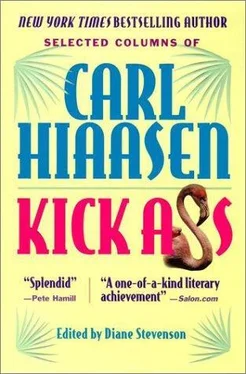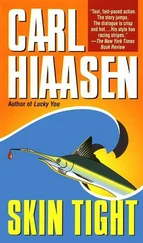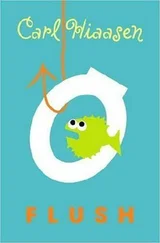The words come from Dr. Robert Q. Marston, vice chairman of the Florida Marine Fisheries Commission. The MFC was created in 1983 to prevent the destruction of coastal fisheries. Because of intense pressure from commercial groups, change has come slowly.
Too slowly, Marston concedes. In a new report to the MFC, the former president of the University of Florida uses uncommonly blunt language to summarize what's gone wrong.
Rather than stand up to the lobbying blitz from special interests, the state repeatedly has enacted weak conservation rules. "Such attempts have failed uniformly," Marston asserts. "Fishery stocks have failed to respond, and ultimately more stringent action is necessary."
Remember how overfishing was allowed to decimate four prized saltwater species—snook, redfish, king mackerel and Spanish mackerel—before emergency measures were taken.
Recently the MFC staff reviewed the survival prospects for 40 Florida species: 16 are considered stable, six are recovering from overfishing, and 18 "are still overfished without an apparently effective recovery plan in place."
One of those is the spotted sea trout, which has declined drastically in numbers because of heavy netting. Efforts to protect the popular food fish have been inadequate, tangled in politics and conflicting scientific data.
Even if you never touch a fishing rod in your life, Marston's call to action is a cause for hope. Wise marine management benefits not only the commercial and sportfishing industries, but every taxpayer, too.
The death of marine habitats would be calamitous for the state's economy, especially tourism. The MFC estimates that recreational fishing now brings in nearly as much money statewide as the citrus industry.
Politicians wouldn't dare stand idle if the orange harvest was being ripped off, but many have done exactly that while the fish stocks were plundered.
The MFC staff wants a streamlined rule making procedure, tougher penalties and stronger, better enforcement. Otherwise, Florida's sea waters will remain vulnerable to the same threats that have depleted two-thirds of the world's major fisheries.
Every Floridian lives within a short drive of a beach, a bay or a river. The vote on Amendment 3 proved that people have a deep affection for these places. Most biologists believe the net ban will greatly rejuvenate stocks of sea trout and other species. It's probably the most important, far-reaching conservation initiative in half a century. And the people had to do it, because the geniuses we send to Tallahassee wouldn't pay attention.
Maybe they will now. If not, there are plenty of other two-by-fours that'll do the trick.
Preserving bay today is good for the future
May 12, 1996
The most spectacular waters of Biscayne Bay are found in Biscayne National Park. This is no quirk of nature.
An unpaved swath of coastline, the last in the county, is one reason the park has stayed so healthy. The Metro Commission has an extraordinary opportunity to keep it that way for your children and grandchildren, and perhaps generations to come.
It's far-fetched, but not impossible to believe that the same political body that erected a mountainous dump on the shore of Biscayne Bay would now vote to protect the rest of it. That's what must happen, or a tragic decline is inevitable.
The southern part of the bay has been shielded from urban pollution by thousands of acres of agriculture and open green space, which acts as a filter for rainfall.
From an airplane, you can see the dramatic contrast in clarity between the water off downtown Miami and the water at the Arsenicker Keys. On some days it's the difference between chowder and gin.
To preserve South Dade's stretch of bay, Biscayne National Park Superintendent Dick Frosthas asked Metro commissioners to make two changes to the master land-use plan.
The first amendment affects 2,700 acres adjacent to the park, which now is designated for urban development. Frost believes the land provides an "essential" buffer for the bay, and should remain farms and open space.
A second, broader amendment asks the county to hold the line against any major housing projects near the national park, until the long-term impact on water quality can be determined.
Frost's recommendations were endorsed 8-1 by Metro's Planning Advisory Board, but that's no guarantee the measures will be approved. Commissioners have been known to ignore their own planners rather than rile their campaign donors.
The amendments are set for a vote Tuesday, and opponents will be out in force. Leading the fight against an expanded park buffer are Homestead City Council members, some of whom continue to invoke hurricane hardship as a justification for subdividing everything in sight.
Councilwoman Ruth Campbell complained that the park's proposal "will stymie the development at the Homestead Air Reserve Base."
A revealing remark indeed. Remember that one selling point of the HABDI giveaway was the assurance that the new airport and commercial park would be not only self-contained, but incompatible with Hialeah-type sprawl.
The proposed buffer area—lowlands between Florida's Turnpike Extension and the air base tract—faces enormous development pressure. As has been the trend in South Dade, some farm owners-turned-speculators are eager to sell.
The problem with cramming thousands of tract houses along Biscayne Bay's drainage corridor is obvious: Asphalt and concrete cannot filter water the way soil does. Instead, rain becomes dirty runoff, degrading the bay.
Those who argue that buffering the park will stunt Homestead's economy are overlooking the 500,000 visitors a year who go there to dive, snorkel and fish.
Besides the Everglades, there's no bigger tourist attraction in South Dade than Biscayne Bay. To endanger it permanently for the short-term benefit of a few powerful interests is reckless.
The superintendent said it best: "You can make a bold and daring decision today to preserve the bay and preserve agriculture in South Dade, or you can sit back and watch it disappear piece by piece.
"Then one day you look out the window and the bay is murky and dark, and you wonder how it got that way. And then it's too late."
One company had courage, fought graft
October 10, 1996
Miami's latest scandal has produced scads of villains and only one shining hero: Unisys Corp.
God knows how many companies have been hit up and shaken down by the crooks at City Hall. Unisys is one that blew the whistle.
Its executives chose not to pay outlandish bribes for the privilege of selling computers to the city. Imagine that. Imagine somebody going to the police and FBI to report a crime.
I know nothing about corporate Unisys or its reputation in the business world, but I know Miamians should be grateful. With their city government a cesspit, any such act of honesty qualifies as an act of courage.
If it weren't for Unisys, a thief-commissioner named Miller Dawkins wouldn't be pleading guilty to bribery and conspiracy, and destined for prison.
If it weren't for Unisys, a conniving bagman named Manohar Surana would still be Miami's finance director. Now a federal informant, Surana, too, is on his way to the slammer.
If it weren't for Unisys, the FBI wouldn't have been tipped to the antics of ex-City Manager Howard Gary, soliciting payoffs disguised as consulting fees.
If it weren't for Unisys, Gary wouldn't have led investigators into the murky world of the municipal bond racket. County Commissioner James Burke would never have surfaced on tape, discussing a $100,000 payment.
And if it weren't for Unisys, Cesar Odio would not stand charged with corruption. Instead, he'd still be city manager, and Miami would still be spiraling blithely toward bankruptcy.
Читать дальше









